Your Cart is Empty
Gemstones are the epitome of natural beauty, right? She’s a godsend. A grand product of time and pressure working in harmony, a symbol of power and purity. Which made us believe they came out as a solid perfect piece and needed just a tad of touch up.
Well, no. Not always.
Natural gemstones aren’t perfect. Turning a rough gemstone into a crown jewel is a design process (and we’re not even talking about the ring design yet!). They need cutting, polishing, and treatments. When gemstones are treated, jewelers add its shine and refine its bling.
And here’s the thing: gemstones are treated (almost) all the time. It’s a practice that’s been around in the industry for so long, you might as well call it a tradition. Treatments are done to refine the precious stone: the colors enhanced, the black spots removed, the clarity improved. And different gemstones require different treatments because gemstones are different all the way down to their atomic level. It’s basically the gemstone’s dressing room.
Even though it may look like a hand interfered in this supposedly natural process, it’s not in any way an attempt to scam you. It is, however, a total scam if you weren’t informed by the seller. Which is why it’s so important for you to understand jewelry lingo, including various ways your gemstones may have been treated. Because, depending on the treatments, the durability and the aftercare of the gemstone might be affected, too.
So what do you need to look out for when purchasing your next precious stone?
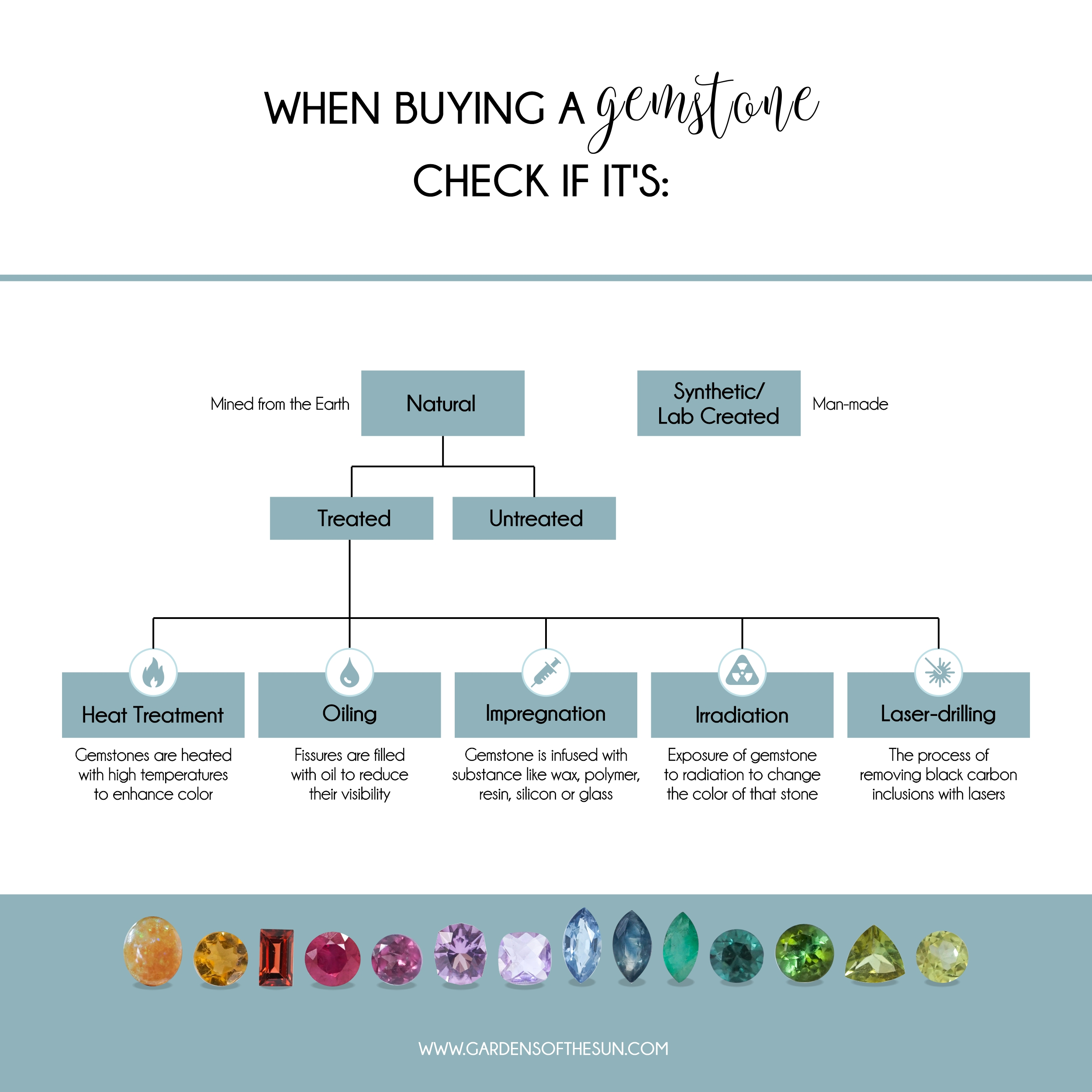
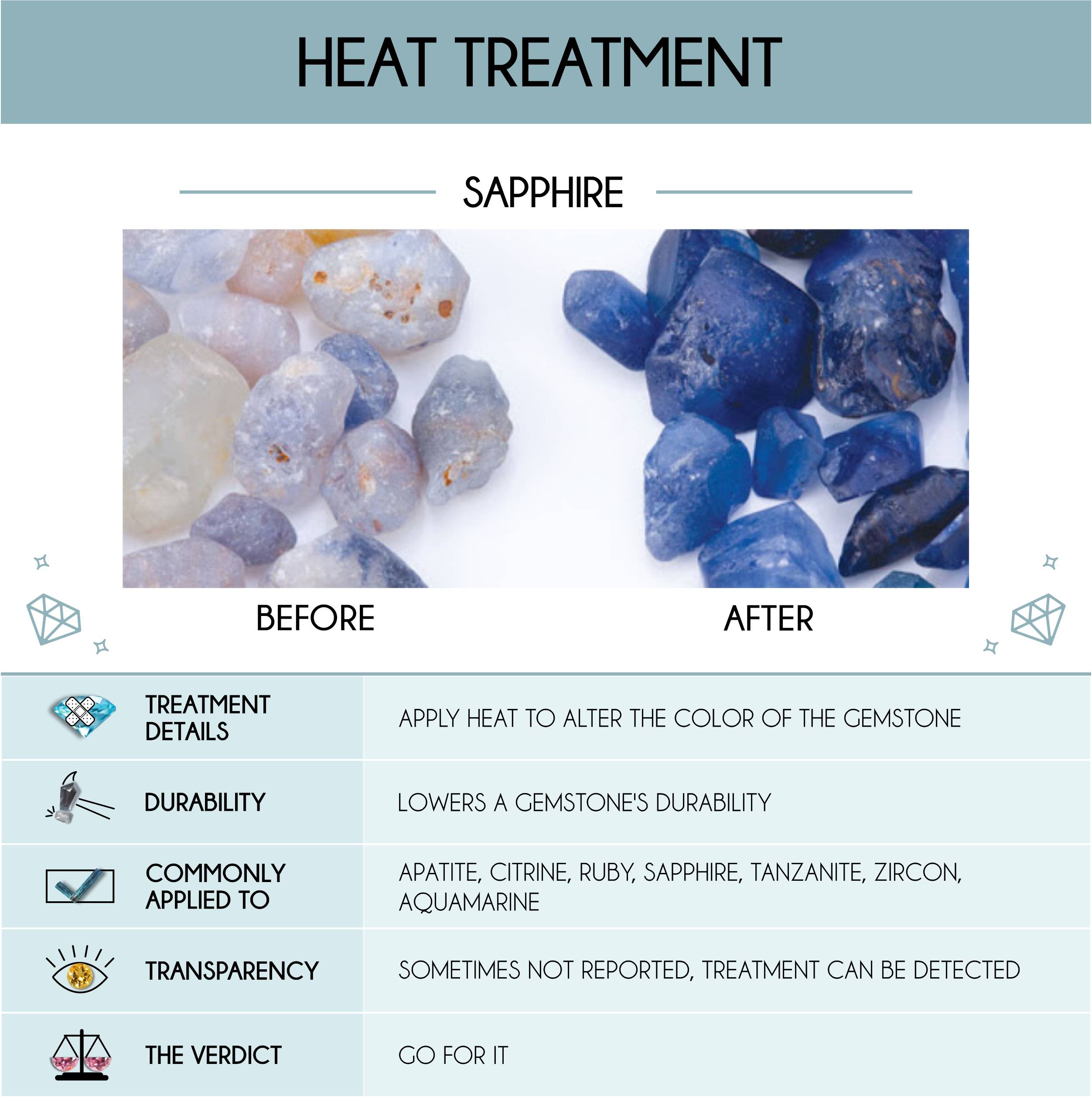
Gemstones are naturally heated when they’re still in the earth’s belly. Heat transforms brown colors to blue, lavender to orange, orange to pink. Once the gemstone is unearthed and the color is pale, a heat treatment may be applied to bring out desired (or marketable) colors of the gemstone. Around 800-1,200 degrees Celsius is considered low temperature heat treatment or gentle heating.
You probably won’t buy citrine in a very pale yellow, but in its famed sunny color; nor would you buy tanzanites in brown, but in its iconic purple meets green. This is all because of heat treatment. In fact, in many gemstones, heat treatment brings out the signature color of the stone.
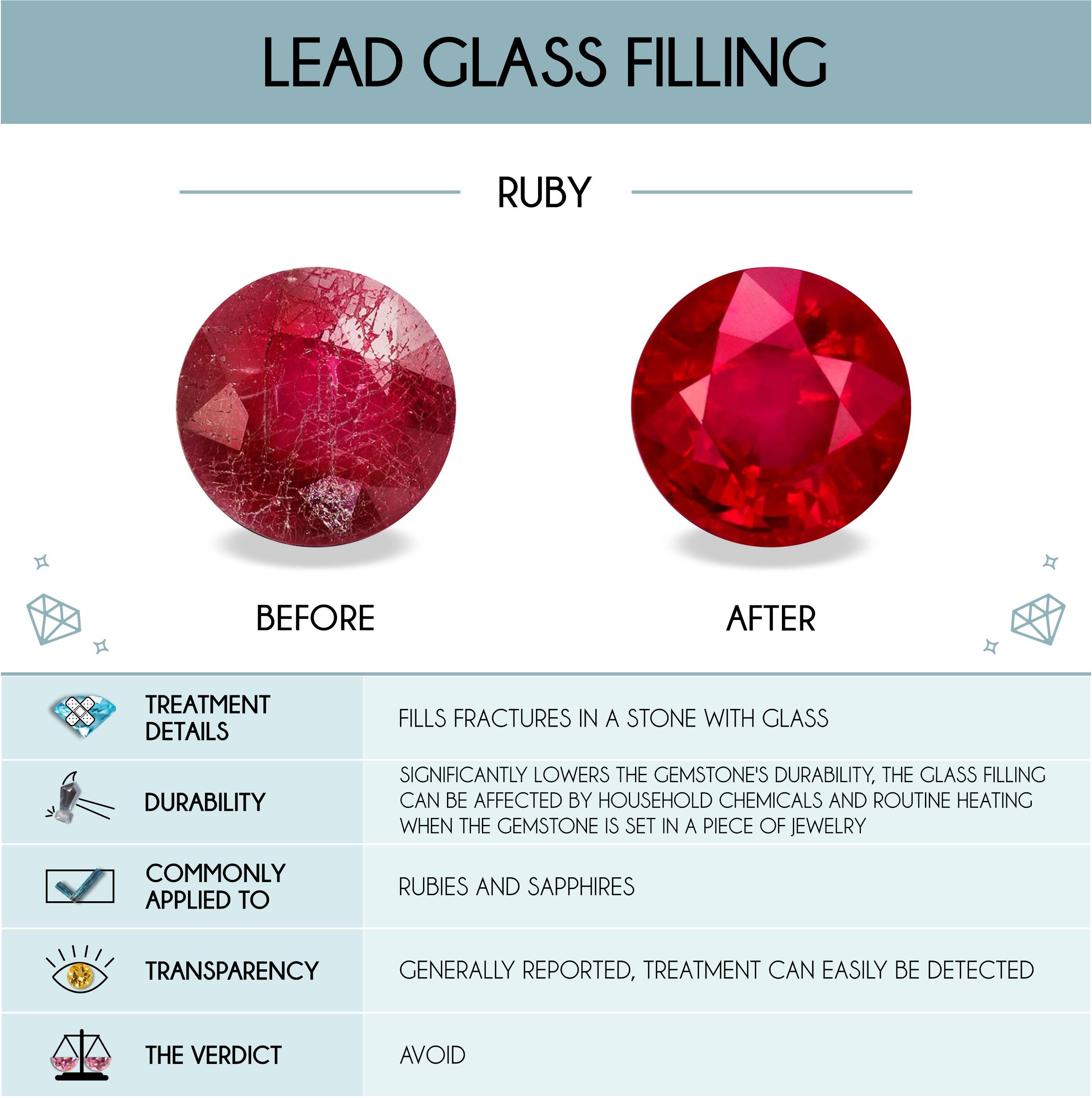
Lead glass filling means a poor quality gemstone may literally be held together by a glassy filler in its fractures. And glass doesn’t have the same hand durability as a ruby, making the stone more fragile than an untreated ruby of similar quality.
These days, better gem labs identify lead glass filled rubies not as ruby but as "composite ruby" or "hybrid ruby" to indicate they can’t fairly be compared with natural ruby. A lead glass filled stone has significantly lower value than an untreated gemstone of similar or even lower quality.
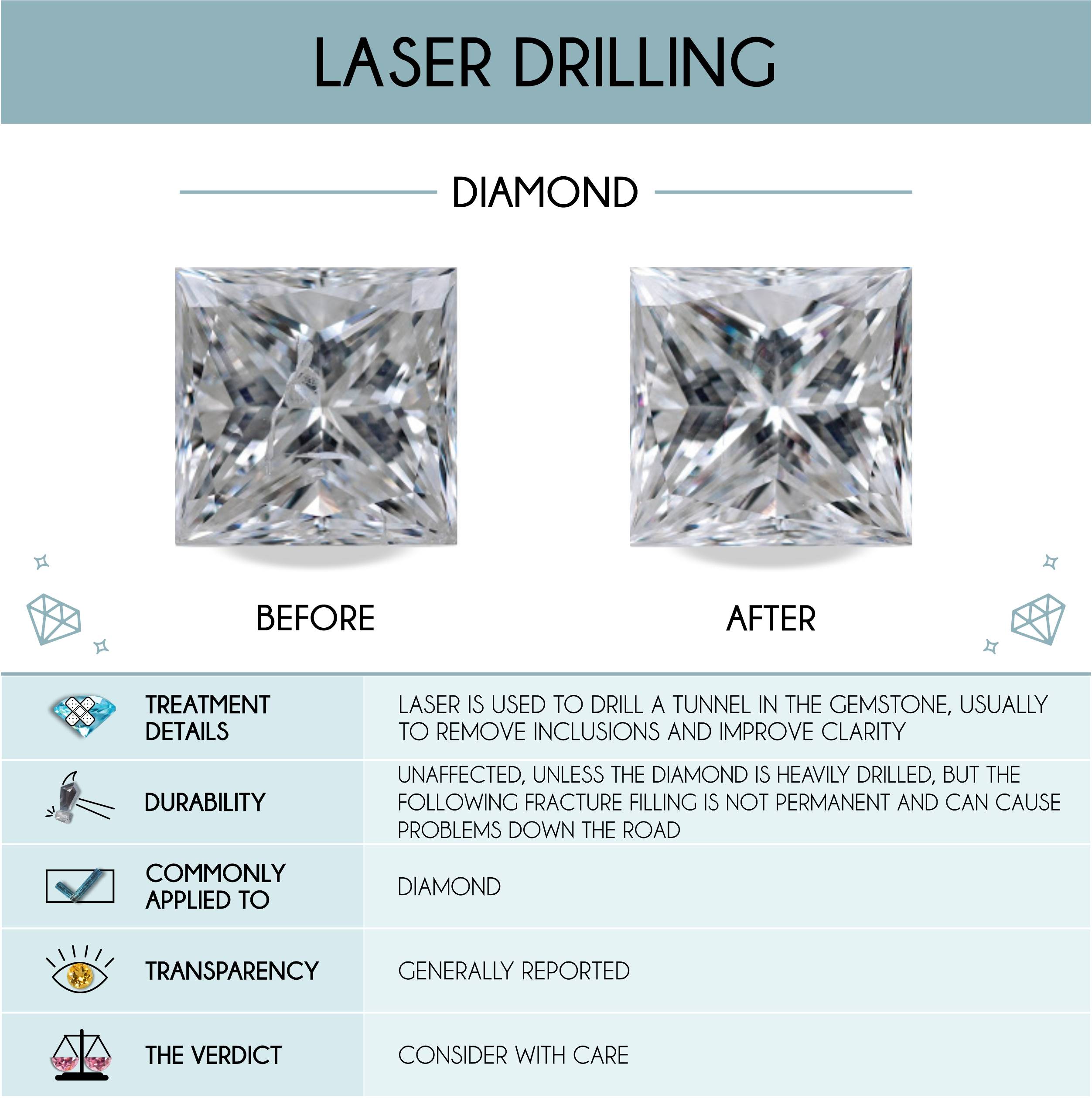
Do all diamonds always come out as crystal clear perfections? No. Thankfully, diamonds are just as flawed as us mortal humans.
A diamond in the market might undergo a heavy drilling process to remove undesirable spots. In this treatment, the diamond is literally being drilled from the surface all the way to an inclusion (a dark spot aka the stone’s birthmark). Through this drilled channel, the inclusion is melted or dissolved in acid. The hole can then be filled with fracture filling. The result? You’d have a flawless piece of diamond.
Since the heat of a laser is intense, diamonds are the only gemstones treated this way.
Even though it significantly enhances clarity and can take its grade up a notch, too many holes can make your diamond more fragile. Make sure to ask your jeweler about the diamond’s history.
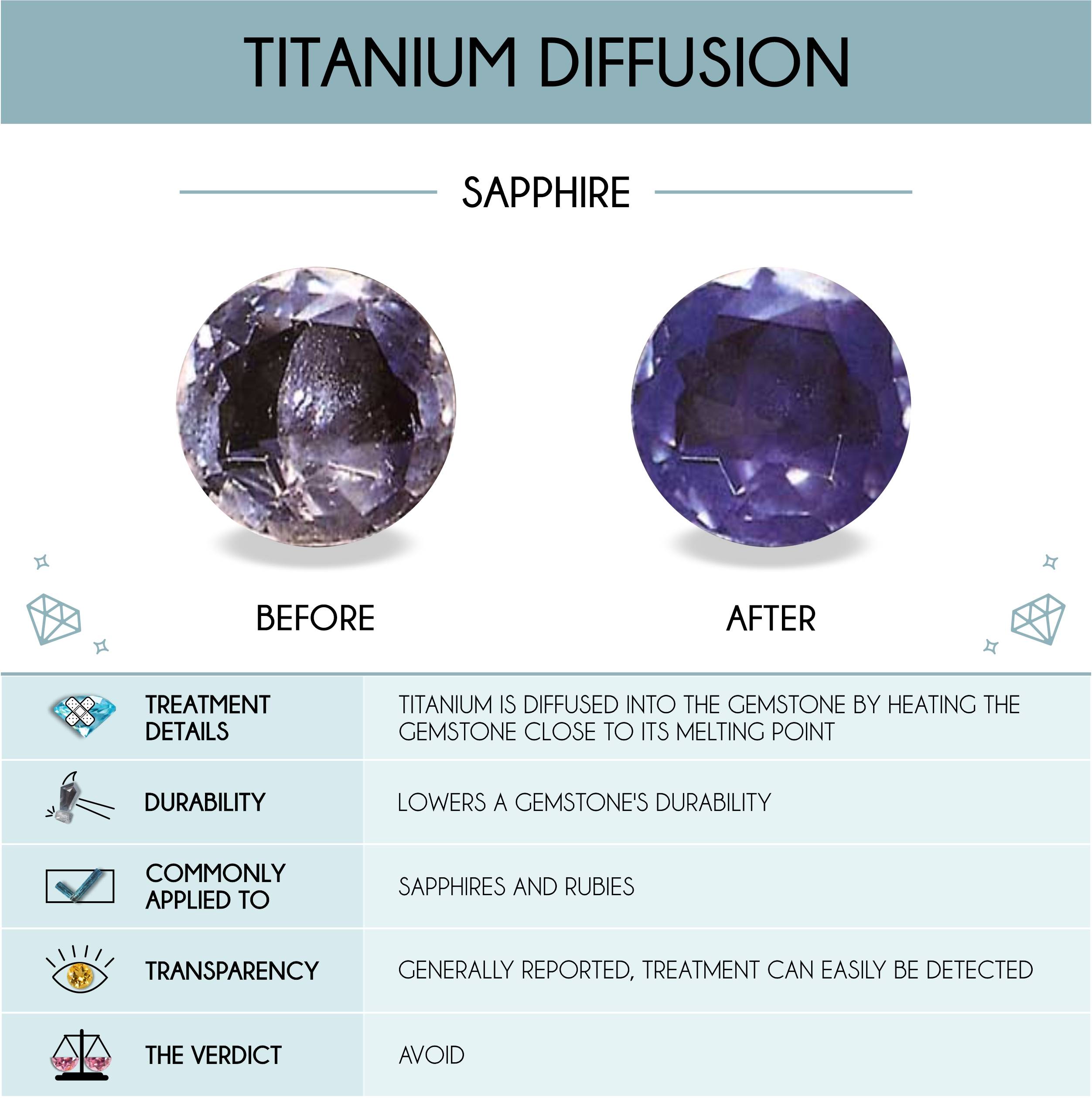
In the case of titanium diffusion, a surface level color is added to a poorly colored stone. The gemstone is heated close to melting point so it can absorb chemicals, like titanium, to alter its color.
However, since titanium has large atoms, it can’t move around the gemstone easily. So, the color stays only on the surface. When the stone chips, nicks or is re-polished, the original color of the stone can be revealed.
This is a treatment you’d want to avoid. Because even if you can get a beautiful color sapphire for a fraction of the price, it’s not going to last.
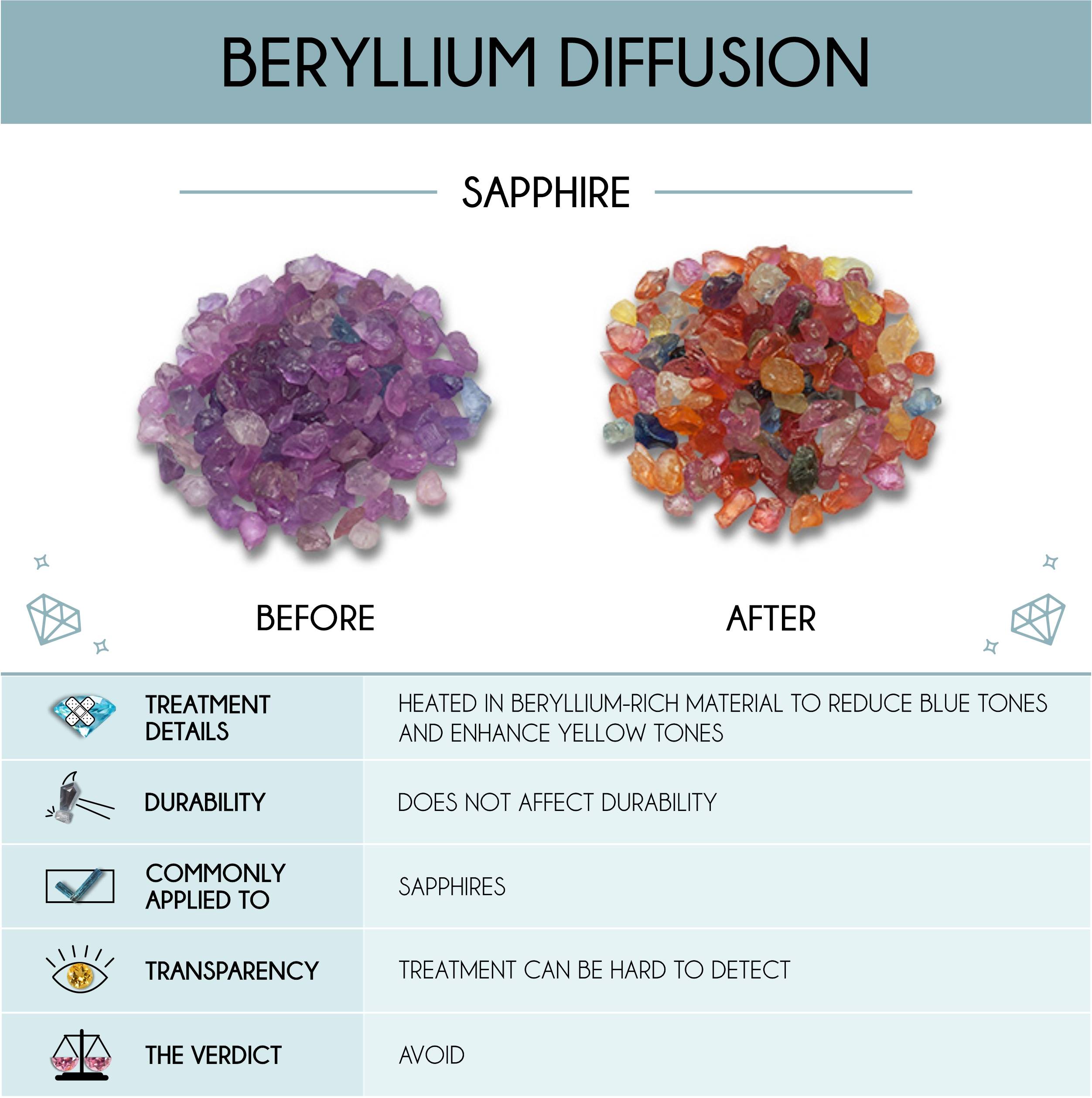
Beryllium diffusion, also known as lattice diffusion, means a natural sapphire is heated in the presence of beryllium-rich material. Gem dealers who want to bring out more yellow or orange tones use this technique. The beryllium atoms diffuse into the gemstone, reducing its blue tones, and consequently, bringing out the warmer, orangey tones.
Beryllium diffusion commonly done on sapphires with natural pale yellow or greenish colors. The treatment tends to bring out the brightness of the original color and is generally stable because the color penetrates the stone deeply without affecting the durability of the stone.
This treatment can be hard to detect. As a consumer, you can use common sense. A vibrantly colored yellow, orange, red or peach sapphire at a ridiculously low price is likely beryllium diffused. You do get what you pay for.
However, beryllium as a chemical is highly toxic. It’s one of the rarest materials on earth; a metal type lighter than aluminium and six times stronger than steel. Used mostly in the manufacturing industry, including nuclear weapons, beryllium can cause irreversible damage to the lungs even in a small amount. Just like how we don’t support the use of mercury in our production, we’d rather not support the use of beryllium in any part of a gemstone’s supply chain.
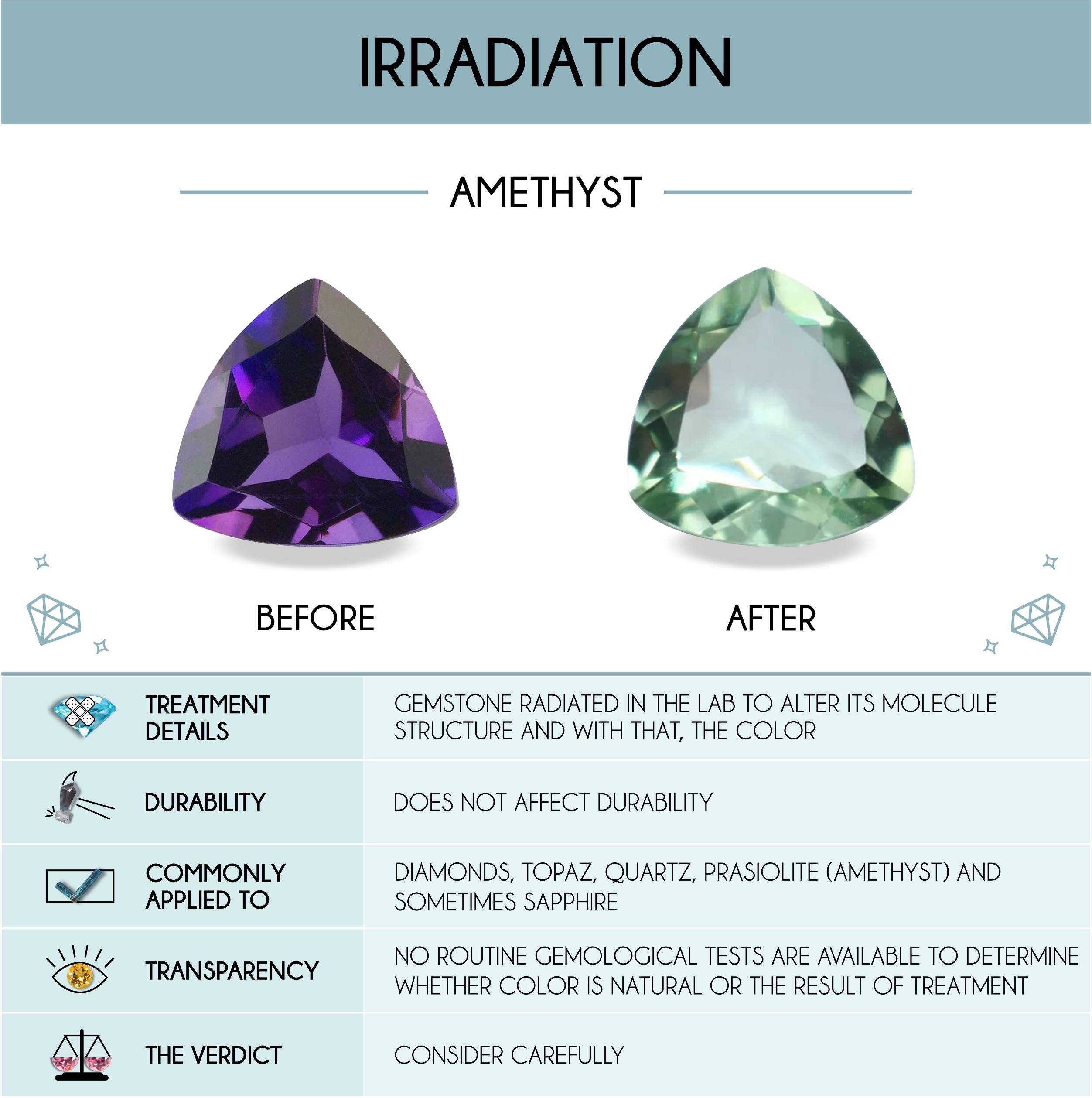
Then there’s irradiation or the use of neutrons, gamma rays, or beta particles to alter colors. Radiation occurs naturally near the Earth’s core, and gemstones buried deep down are constantly exposed to it. Irradiation is the process of radiating a gemstone in the lab, where gemstone nerds and scientists attempted to cut down millions of years of natural radiation to mere minutes. Irradiated gemstones are generally safe to wear.
In diamonds, topaz, prasiolite (irradiated amethyst turns green) and quartz, the color from irradiation tends to last. However, very high temperatures, like those from a jewelers’ torch when setting the stone, can affect the color.
If you’re ever having your jewelry with an irradiated gemstone repaired, make sure you tell your jeweler about any treatments to avoid losing color.
In sapphires their color may fade from consistent exposure to strong light. So although the gemstone itself is still durable, the color may not be. The verdict? You can get a beautifully colored sapphire at a cheap price, but you’ll eventually end up with cheap color.
Irradiation for blue topaz is so common, you can safely assume your London blue or Swiss blue topaz is irradiated.
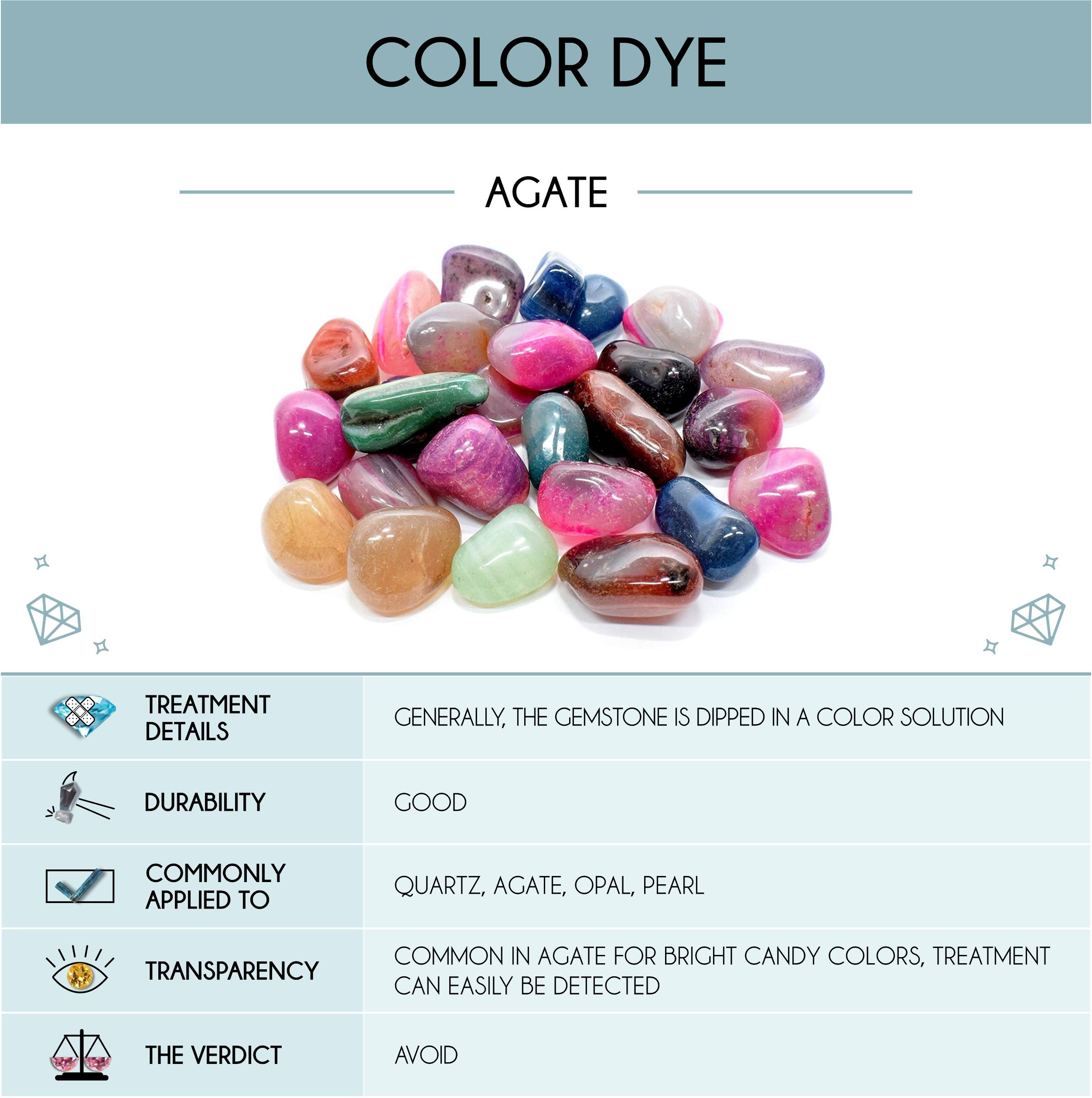
Color dye is commonly used in gemstones that are porous such as agate. Agates usually have alternating layers of colors in various thickness or transparency (imagine planet Jupiter!), but dyed agates can be even-colored. Since agates are porous, dyes can enter the structures easily and leave dramatic changes. Natural agates are usually red or brown, but you can get a pink or lilac version with dyes. Different solutions are used to create different colors.
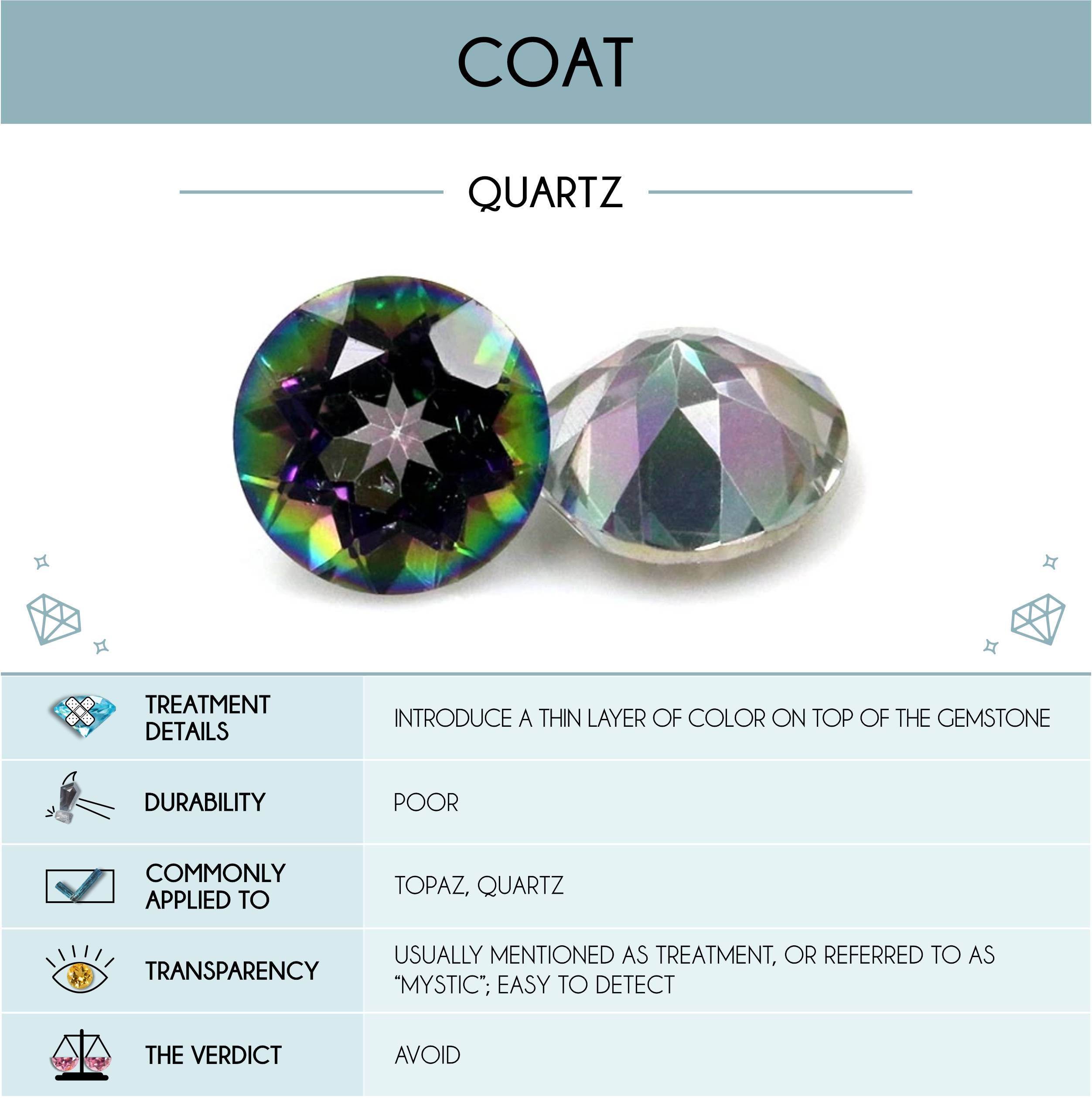
Unlike heat treatments, color coated gemstones can easily look cheap and fake. As the name suggests, only a thin film of color is applied to the surface of the gemstone; it doesn’t actually permeate into the stone. Coating causes the gemstone to lose its depth, giving it a shallow, artificial appearance. The coating doesn’t last and extra care is needed. Topaz, mostly mined as a colorless gemstone, is often color coated to make it more attractive to the market. This is then marketed as mystic topaz. If you’re going for a colored topaz, an irradiated topaz is more reliable.
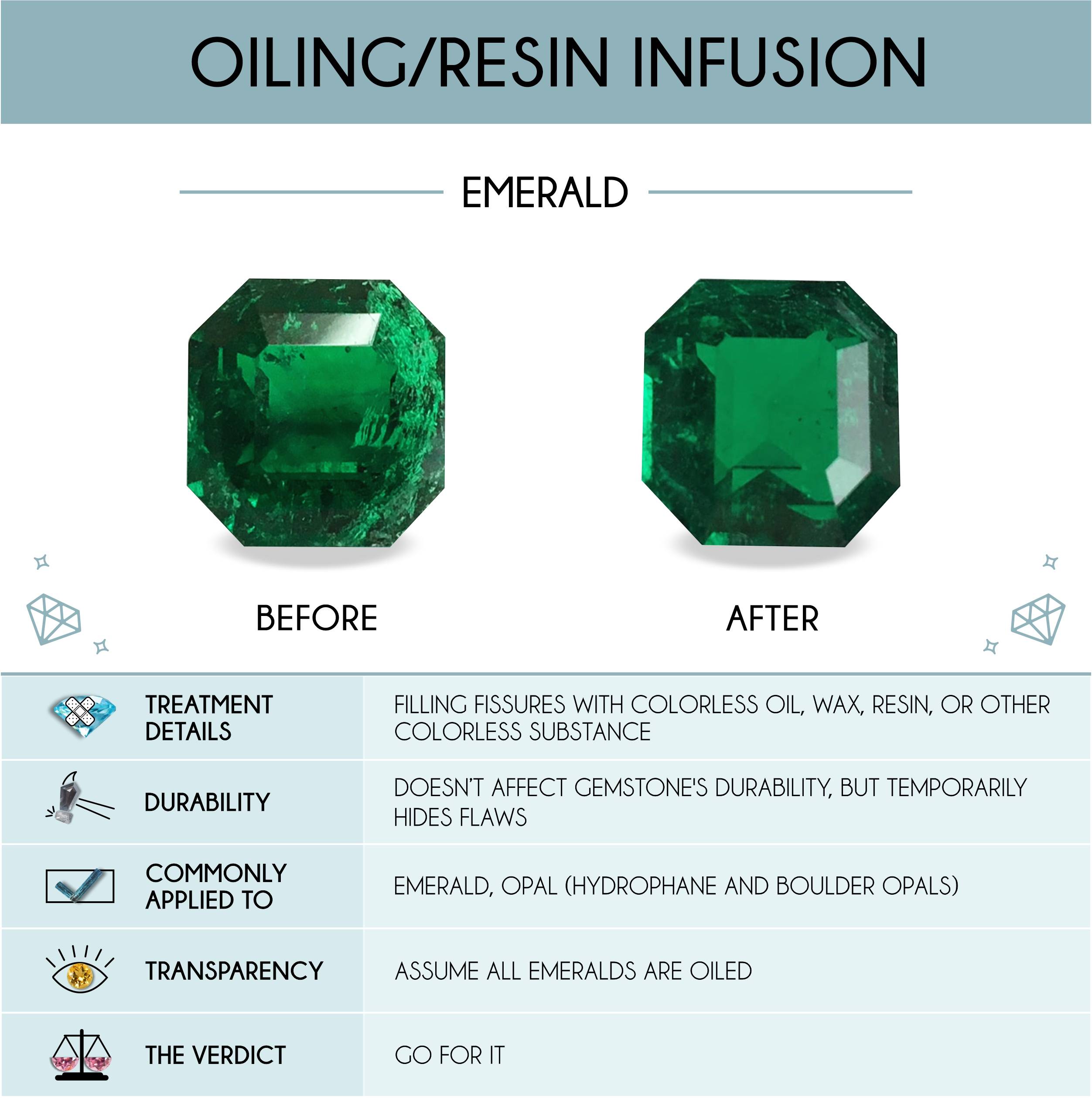
Does rubbing gemstones with oil sound like wizardry to you? It sure is, and it does wonders to the gemstone, too. Emerald is one of the few gemstones often infused with oil or resin. Emeralds are heavily included, which means that the gemstone has plenty of tiny fissures and cracks.
Oiling/resin infusion is a common industry practice to treat emeralds by having colorless oil (usually cedar oil) penetrate and enter its cracks. It’s generally understood that oil treatment lasts for one or two years, but you can also get it re-oiled professionally.
If you own a piece of emerald, assume it has undergone oiling treatment, and avoid steam cleaning and heavy chemicals while wearing it.
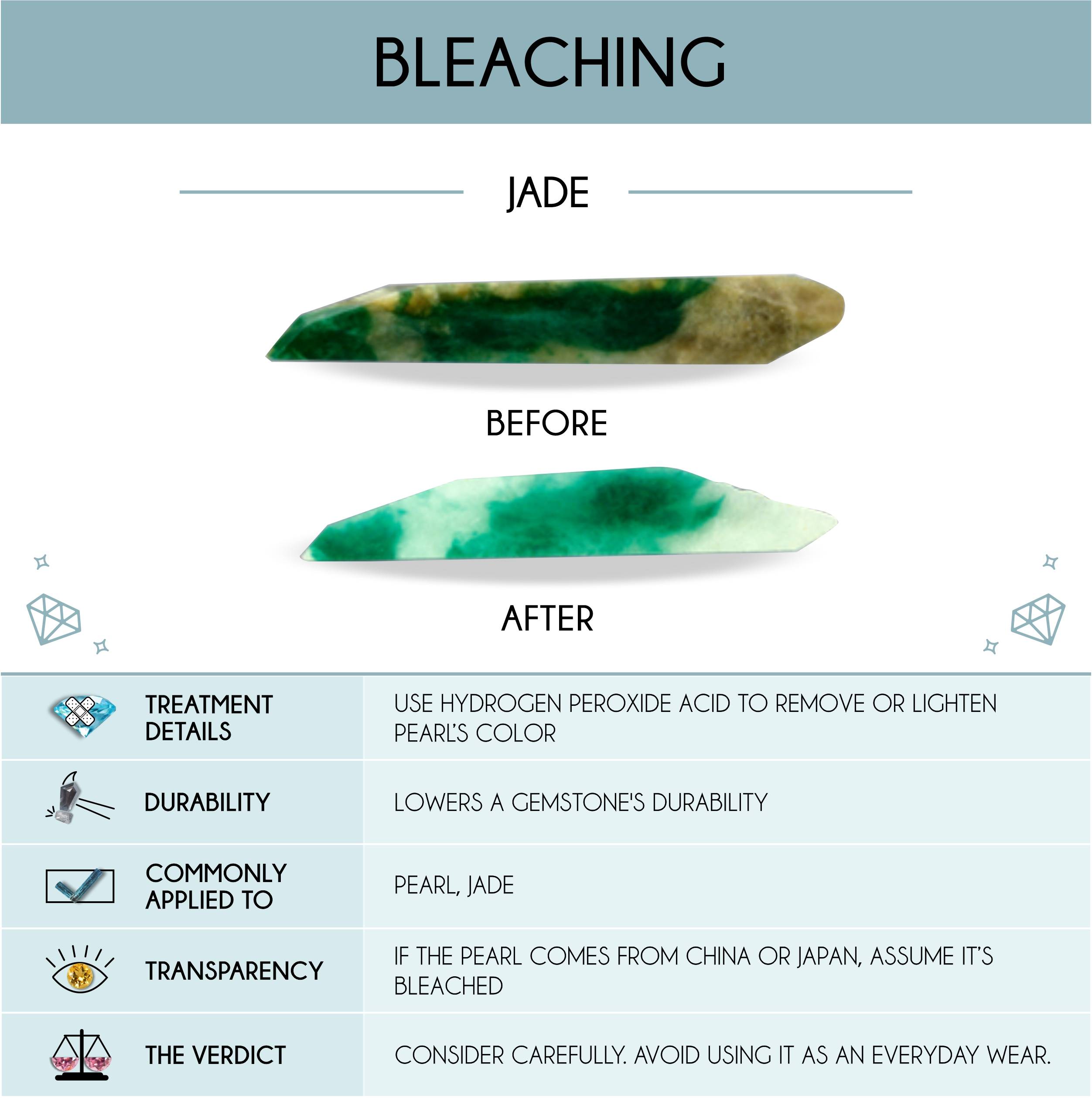
Bleaching is commonly done on pearls because uniform colored strings of pearls are more desirable. After being harvested from the sea, the pearls are immersed in a hydrogen peroxide solution while being lit under strong fluorescent light. The treatment goes for one week. Pearls treated with fluorescent light tend to be whiter and have a more shiny luster.
Like many other treated gemstones, avoid wearing pearls when washing your dishes or applying perfume!
The bottom-line question is this:
Do you want your gemstones natural or flawless? Would you feel cheated knowing your blue topaz was once colorless? Many jewelry designers and dealers are happy to sell treated gemstones, since this allows those on a budget to flaunt a sapphire as stunning as Lady Di’s!
But it’s always advisable to know your gemstone inside out. Just like buying a house, you’d want to know what she’s been through, both the good and bad.
Yes, we’ve got to admit acquiring detailed information from our suppliers is tough work. And sometimes even lab work won’t do the job. Whether we’re a 100% sure a gemstone has been treated or we feel uncertain about it, we’ll let you know. We say it as it is. And we’ll let you know what this means for you, in terms of maintenance and care.
Feeling overwhelmed? Shoot us an email. And when you’re ready, let’s get back to the fun!







